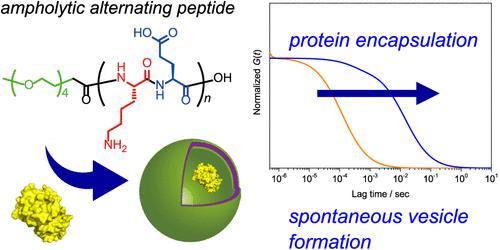由赖氨酸/谷氨酸交替序列组成的两性多肽可同时形成多离子复合囊泡
IF 4.7
Q1 POLYMER SCIENCE
引用次数: 0
摘要
胶束和囊泡等纳米结构通过其带电聚合物成分之间的静电相互作用进行自组装,已被广泛用作材料输送平台。在这项研究中,我们设计了具有赖氨酸和谷氨酸残基交替序列的两性聚合肽,并通过化学酶聚合法合成了这种肽。这种交替序列是通过胰蛋白酶催化二肽单体聚合实现的。由于阴离子和阳离子残基之间的静电作用,所制备的两性肽在水中自发形成了大小为 100-200 纳米的纳米级集合体。在这些两性交替肽的 N 端用四乙二醇(TEG)修饰可形成稳定的纳米级集合体,而由赖氨酸和谷氨酸随机序列组成的肽则会形成大的聚集体,即使经过 TEG 修饰,其稳定性也会下降。使用场发射扫描电子显微镜和原子力显微镜进行的形态学观察显示,所获得的集合体呈球形和中空,表明 TEG 修饰的两性交替肽自发形成了囊泡。这些囊泡能够在其中空结构中封装模型荧光蛋白,而不会因结构坍塌而导致荧光损失,这证明了这些纳米载体在材料输送系统中的应用潜力。本文章由计算机程序翻译,如有差异,请以英文原文为准。

Ampholytic Peptides Consisting of an Alternating Lysine/Glutamic Acid Sequence for the Simultaneous Formation of Polyion Complex Vesicles
Nanoarchitectures such as micelles and vesicles that self-assemble via electrostatic interactions between their charged polymeric components have been widely used as material delivery platforms. In this work, ampholytic peptides with a sequence of alternating lysine and glutamic acid residues were designed and synthesized via chemoenzymatic polymerization. This alternating sequence was achieved by trypsin-catalyzed polymerization of a dipeptide monomer. Due to the electrostatic interaction between the anionic and cationic residues, the prepared ampholytic peptides spontaneously formed nanosized assemblies with a size of 100–200 nm in water. Modification with tetra(ethylene glycol) (TEG) at the N-terminus of these ampholytic alternating peptides resulted in the formation of stable nanosized assemblies, while peptides consisting of random sequences of lysine and glutamic acid formed large aggregates with deteriorated stability even with TEG modification. Morphological observations using a field-emission scanning electron microscope and an atomic force microscope revealed that the obtained assemblies were spherical and hollow, indicating the spontaneous formation of vesicles from the TEG-modified ampholytic alternating peptides. These vesicles were able to encapsulate a model fluorescent protein within their hollow structures without structural collapse causing loss of fluorescence, demonstrating the potential of these nanocarriers for use in material delivery systems.
求助全文
通过发布文献求助,成功后即可免费获取论文全文。
去求助

 求助内容:
求助内容: 应助结果提醒方式:
应助结果提醒方式:


